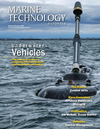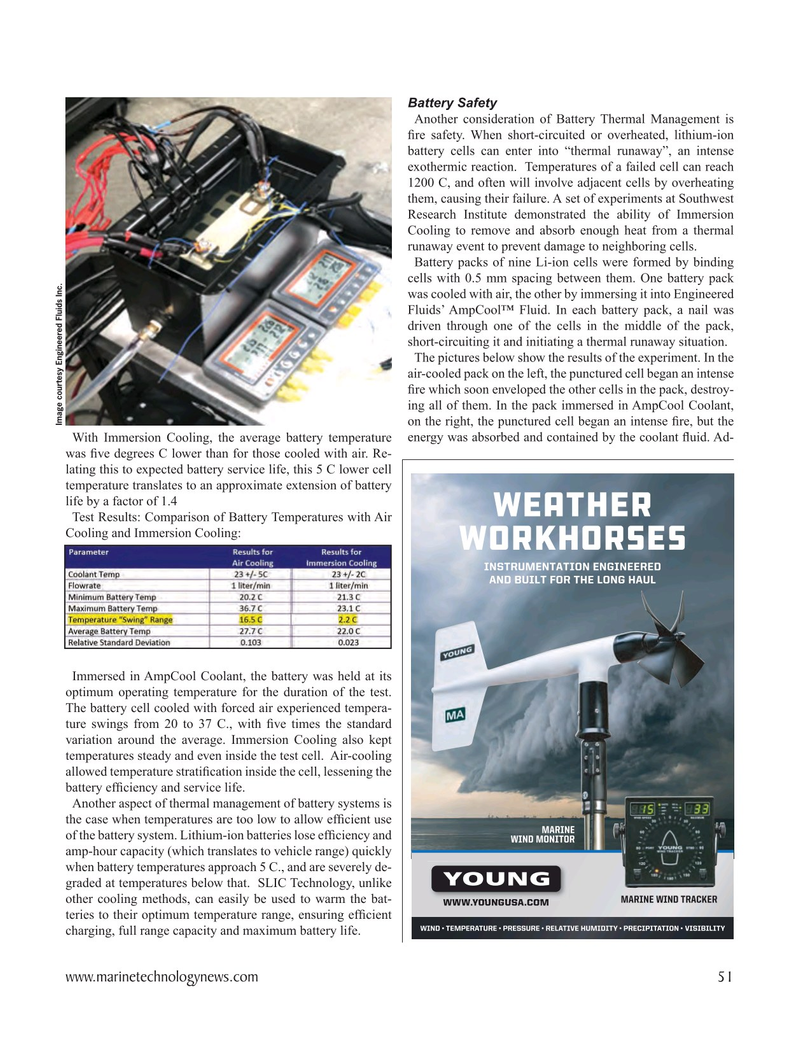
Page 51: of Marine Technology Magazine (January 2024)
Read this page in Pdf, Flash or Html5 edition of January 2024 Marine Technology Magazine
Battery Safety
Another consideration of Battery Thermal Management is ? re safety. When short-circuited or overheated, lithium-ion battery cells can enter into “thermal runaway”, an intense exothermic reaction. Temperatures of a failed cell can reach 1200 C, and often will involve adjacent cells by overheating them, causing their failure. A set of experiments at Southwest
Research Institute demonstrated the ability of Immersion
Cooling to remove and absorb enough heat from a thermal runaway event to prevent damage to neighboring cells.
Battery packs of nine Li-ion cells were formed by binding cells with 0.5 mm spacing between them. One battery pack was cooled with air, the other by immersing it into Engineered
Fluids’ AmpCool™ Fluid. In each battery pack, a nail was driven through one of the cells in the middle of the pack, short-circuiting it and initiating a thermal runaway situation.
The pictures below show the results of the experiment. In the air-cooled pack on the left, the punctured cell began an intense ? re which soon enveloped the other cells in the pack, destroy- ing all of them. In the pack immersed in AmpCool Coolant, on the right, the punctured cell began an intense ? re, but the
Image courtesy Engineered Fluids Inc.
With Immersion Cooling, the average battery temperature energy was absorbed and contained by the coolant ? uid. Ad- was ? ve degrees C lower than for those cooled with air. Re- lating this to expected battery service life, this 5 C lower cell temperature translates to an approximate extension of battery life by a factor of 1.4
Test Results: Comparison of Battery Temperatures with Air
Cooling and Immersion Cooling:
Immersed in AmpCool Coolant, the battery was held at its optimum operating temperature for the duration of the test.
The battery cell cooled with forced air experienced tempera- ture swings from 20 to 37 C., with ? ve times the standard variation around the average. Immersion Cooling also kept temperatures steady and even inside the test cell. Air-cooling allowed temperature strati? cation inside the cell, lessening the battery ef? ciency and service life.
Another aspect of thermal management of battery systems is the case when temperatures are too low to allow ef? cient use of the battery system. Lithium-ion batteries lose ef? ciency and amp-hour capacity (which translates to vehicle range) quickly when battery temperatures approach 5 C., and are severely de- graded at temperatures below that. SLIC Technology, unlike other cooling methods, can easily be used to warm the bat- teries to their optimum temperature range, ensuring ef? cient charging, full range capacity and maximum battery life. www.marinetechnologynews.com 51
MTR #1 (50-63).indd 51 1/31/2024 10:59:53 AM

 50
50

 52
52
